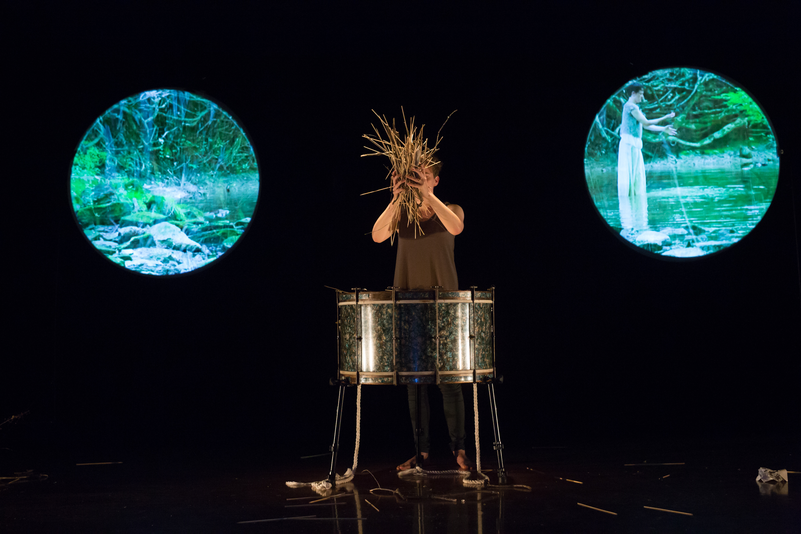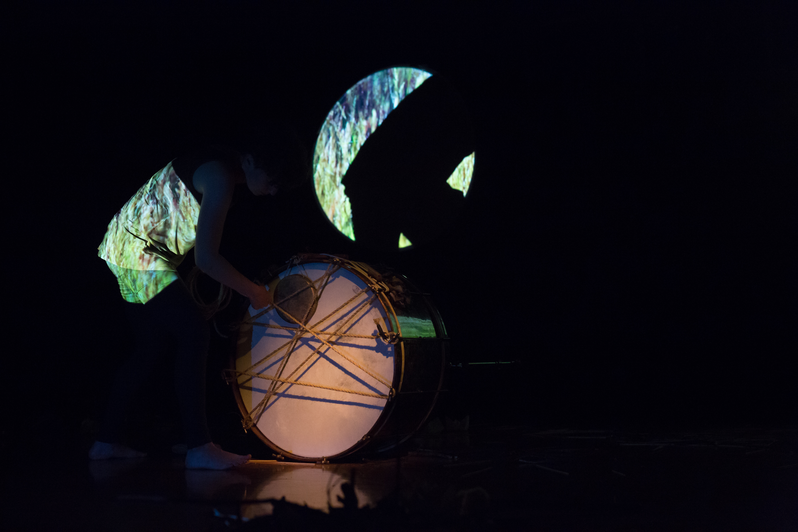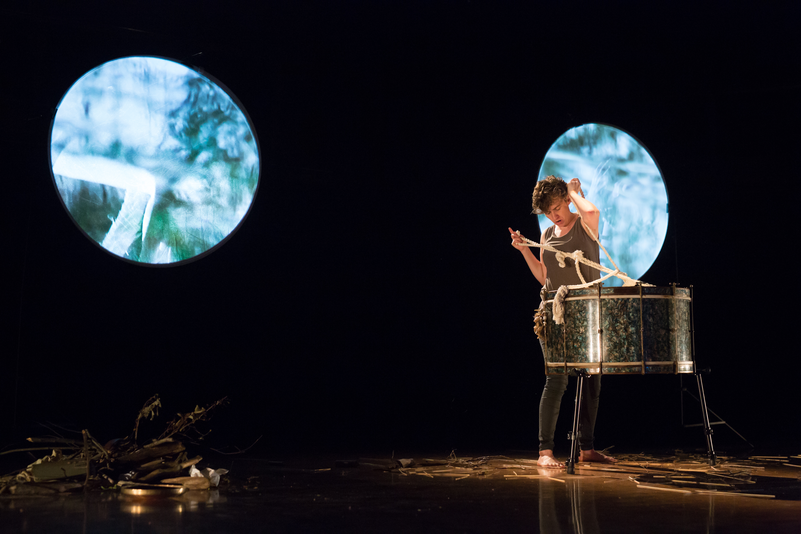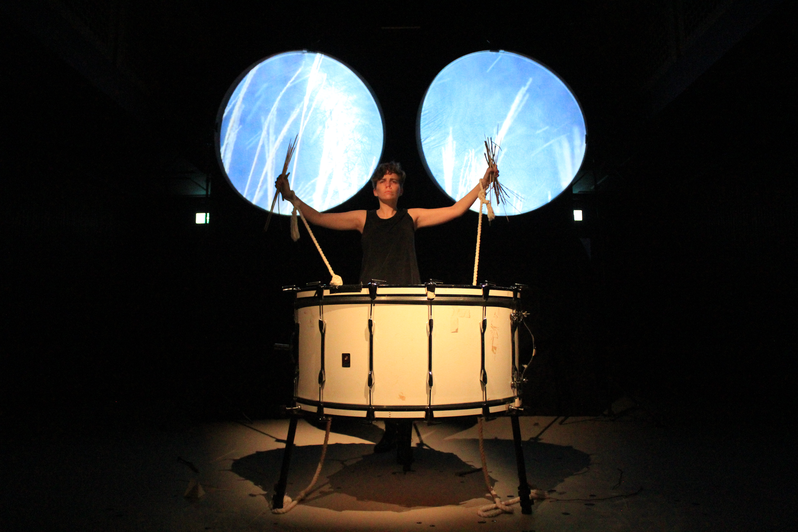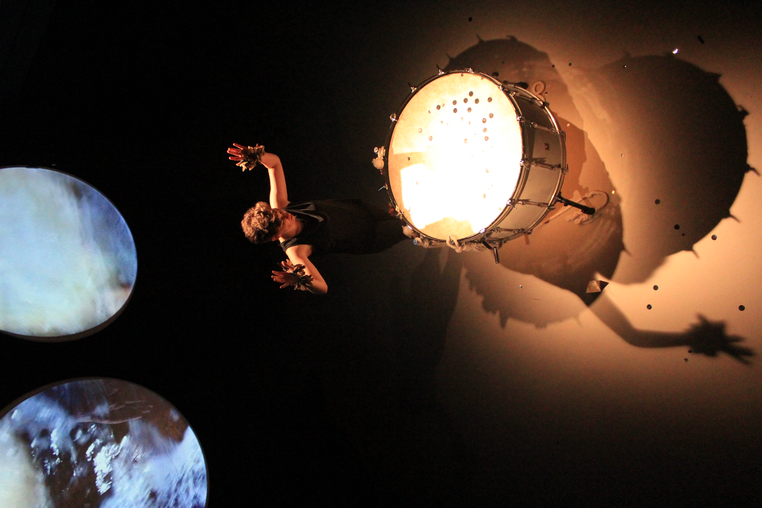A brief description of the collaborative process
What Noises Remain was created through a highly collaborative process across two years. The starting point was to reimagine The Tempest via storytelling strategies using objects, the body moving in space, and multi-media elements. First, Swendsen and Torrence re-constructed the text through various strategies; second, the video material was collected and structured by Swendsen and Torrence; third, the audio playback material was collected and structured by Swendsen; lastly, the performance material and staging were created through devising methods. The piece’s score is text instructions that follow a timeline. The piece underwent one major revision in 2017, which largely affected the staging and scenography. This is the first piece within the project where the composer offered to share authorship with Torrence.
Performance History
24 September 2016: Oberlin Conservatory of Music, Oberlin, Ohio, USA
19 January 2017: Sentralen, Oslo, Norway
25 January 2017: Stormen, Bodø, Norway
What Noises Remain (2016)
Created by Peter Swendsen & Jennifer Torrence
Performed by Jennifer Torrence
With significant contributions and input from
Amy Miller, Asha Tamarisa, Christiana Rose, Vera Rudi, Gunhild Mathea Olaussen, Juliana Zara, Daniel James
We sometimes go in search of the remnants and records of past events, but we also sometimes find ourselves immersed in a place with a history unknown to us, a history almost entirely reclaimed by the place itself. In these places, on this island full of noises, we see and hear beneath surfaces, catch fragments of meaning at the edges of perception, and project ourselves into a narrative that is both tangible and imagined. Here there was captivity, freedom, cunning, and hope. Desolation, destruction, and renewal. Here was both the center of the world and the place of exile. Fragments remain. Magic remains. Whether this be or be not, I’ll not swear...
Duration: 50 minutes
Special thanks to Oberlin TIMARA Department, Oberlin Dance Department, Oberlin Cinema, Studies Department, John Talbert, Mike Rosen, Elizabeth Peacocke, Adina Filipoi, Carter McAdams, Nusha Martynuk, Dan King, Jøran Rudi, NoTAM Studios, Henrik Hellstenius, Nick Jones, Wendy Hyman
With support from Arts Council Norway, Norwegian Artistic Research Council, Music Norway, Oberlin Conservatory of Music
In December 2015 Peter Swendsen and I met for the first major development period for the piece, What Noises Remain (2016). Peter and I both had a desire to incorporate scenography and staging in our retelling of The Tempest, however this was new terrain for both of us in our work. We chose to invite scenographer Gunhild Mathea Olaussen, into our process as a consultant in order to find strategies for approaching these aspects of the piece. To begin our process, she provided us with a list of questions. Peter and I answered her questions separately. Below the reader can find 1) the questions, 2) Peter's answers, 3) my answers. The piece and our use of scenography changed drastically from this point on.
December 2015:
Gunhild Mathea Olaussen’s Questions:
THEME / SCRIPT
- How do you relate to the script (The Tempest)? Regarding composition/development of material - how do you relate to the dramaturgical narrative of the script? - If the script is used as inspiration: Which aspects do you especially concentrate on? You are mentioning confinement, control and wonder in your project description; how do you use these keywords when working creatively? - How do you treat these different aspects: Dramaturgy (I.e. linear or as a collage/series of topics/images), plot, characters, actions, temperaments. - Have you thought of any visual interpretations (symbols, shapes etc)? For example, what about working on circularity, both regarding space, elements, sound, movement, as the storm draws the boundaries around the island, (and the plot, the characters etc).
THE DIFFERENT LEVELS
- The personal: intimate human (the spiritual, thoughts, doubts etc) - The relational aspects of the story: between characters, elements on stage, relation to the audience. - The externals: weather wind, time, (destiny involved?).
THE DIFFERENT PARTS
1) Space / audience 2) Performers - Performed sound - Performed movements - Performed vocals (?) 3) Pre – recorded / electronic sound 4) Objects 5) Video 6) Lights
Some specifics / questions:
1) SPACE / AUDIENCE
- What size/ what kind of venues are you looking for? - Is the audience involved? Are you breaking or keeping the fourth wall (how and why)? - Where is the audience seated? - Perhaps you want to use some structural ideas from the geography of The Tempest as inspiration in how you organize the room? – An island, a limited area?
2) PERFORMERS
- Universe: How do you relate to real time performing as performers, versus imaginary storytelling through characters (how and why)? - Performed sound - Performed movements - Performed vocals (?)
3) PRE – RECORDED / ELECTRONIC SOUND
- Pre composed sound: Who is the sender – what does it represent in the universe of the piece? Do you want to use space when working on sound (surround, acoustic sound, PA / local loudspeakers?) - Video sound: (at all?) (Who is the sender – what does it represent in the universe of the piece?) - Are all sounds (including the pre recorded) activated by the actors on stage, or are some triggered by the sound engineer? - Does the sonic qualities communicate with the visual qualities, and how? Open/closed, hard/soft, rounded/edgy, material similarity etc?
4) OBJECTS
- Materials – any thoughts? What, why, how and how many? - What kind of objects are you thinking about? (I remember us talking about a tree, or a gathering of objects, that also functioned as an instrument Jennifer?)
5) VIDEO
- How are you planning to organize the screens on stage? What kind of universe is this room full of screens (I suppose this is your present?)– how do you think of them as an object? - How does our character relate (if relating) to the video? - Is this a memory, a parallel universe, or not relating to the happenings on stage – a “something else”? Who is the sender of the videos? I understand that these questions might seem a bit diffuse, but quite often screens on stage are used without a grounded thought of what they signify. So the point about these questions is rather to start up a conversation that can lead us to an articulated (grounded) usage of this 2d universe.
- Performer (to what degree is the performer a character?) (You touched upon this in your email Jennifer, but it would be good to deepen my understanding).
6) LIGHTS
- Are you working with a lighting designer? How do you want to use lights to create focus/narrative? - The possibility of using lights to focus on materials/objects as well as characters (materials moving without an actor interacting, could represent another voice – the storm, the nature etc). - Layers of focus (actors, surroundings, screens), and the possibility of rapid shifts in between them (like editing a film), or to create spatial levels. - Use of video screens as light sources?
Peter’s Answers
THEME / SCRIPT
- I relate to the setting of the action—the island—though I’ve always imagined it in the “north” rather than “the tropics.” The action of the play was, at least at first, secondary for me, though I have since become more attached to the text itself. The dramaturgy is fluid for me--that is, I am comfortable finding small excerpts and/or reordering time. I am also interested in adding excerpts from other sources and/or things of our own devising.
- Magic, freedom/confinement, isolation, vague sense of time, nature, distance/proximity, remoteness.
- Collage for sure, though there is likely to emerge a linear timeline for our purposes as well. It may be different than the linearity of the original play. Characters are also collaged, layered, combined. Some are omitted altogether.
- Circularity is an element for sure. The island, the drum, the idea of looking “out” through binoculars/telescope (circular frames). Also the circularity of time spent in isolation, the meditation of repeated actions.
THE DIFFERENT LEVELS
- Weather and the natural world are certainly elements. The internal world(s) of the character(s) as well. Magic/spirits, more so than the “spiritual.” Destiny is not something I’ve considered very much up to now.
Some specs / questions:
1) SPACE / AUDIENCE
- I’m thinking small-medium venues. I keep using the term “chamber music,” which may or may not be accurate but perhaps gives a sense of scale. The fourth wall question is open. The play itself breaks the fourth wall, particularly at the end. My hunch is that we do not break it, though I’m not opposed. Because of video and sound projection, the audience is mostly seated in front, perhaps with a little semi-circle, but I don’t expect that a full surround would quite work (though it would be lovely in some ways).
- An island, a limited area? Yes, I think so. We’ve talked about Jen’s stage space being an island defined by a large piece of fabric that could be pulled on and off (by her) and also shrink and grow (with the “tides”). The primary feature of this space is a bass drum with some peripheral instruments/apparati. There are also 2-3 other clusters of smaller instruments.
2) PERFORMERS
- The live performer inhabits (or is inhabited by) a number of roles: characters from the play, the nature of the island, her own character as visitor to the island. Her performed sound, movement, and vocals serve all of these roles.
3) PRE – RECORDED / ELECTRONIC SOUND
- This sound is sometimes the environment, sometimes the “internal” soundscape of character(s), sometimes part of the narrative, possibly including recorded text. It may also be an extension of the sound produced on stage, either through coordinated timing or live processing. Sound location is important. Surround sound could be nice, depending on the venue, though I also prefer to keep sound sources attached to the visual/gestural world of the piece when live performance is involved. We have, though, talked about small local sound sources like tape players or radios, in addition to the main speakers.
- Video sound? Possibly some “diegetic” sound, though it would likely be composed rather than taken directly from the video. Some of the gestural actions in the video have wonderful sound, such as Amy in the tall grass. This could also be produced live by Jen and her instruments--that may in fact be the most interesting.
- Some sounds are triggered/projected remotely.
- Does the sonic qualities communicate with the visual qualities, and how? Yes. Not entirely sure of the details here yet, but connections exist for sure. Counterpoints also.
4) OBJECTS
- Instruments to be played. These are mostly small enough that they could have been brought to the island, and they are also primarily “natural” materials--wood, rocks, clay, etc. There are some metals as well, and then the big drum. Other objects might include wood (logs are mentioned in the text), a staff, books, clothes/fabrics, eating and drinking tools/vessels, other tools.
5) VIDEO
- At the moment, we are thinking that one video will be projected on to the bass drum surface (and perhaps the area surrounding). A second video, sometimes split into two distinct images, would appear behind and above Jen. The frames for this video may also be circles (like binoculars). The screens themselves could also be circles, or not--perhaps sometimes we would want a full rectangle or other shapes?
- She interacts with the video on the drum. Less so with the videos behind, I think.
- It is a memory or imagining of what has happened in the past and also an extended visualization of the present. It is also a way to create a visual backdrop for the “present” happening on stage. So most of what appears in the video is directly related to Jen--her memory, imagination, environment--though some of it is “sent” by the place itself.
- Jen is primarily her own character. She finds herself on this island where the play took place and is trying to piece together what happened in the past. In doing so, she imagines herself as various characters from the play (and/or from elsewhere). She is a hybrid of herself and these characters and also becomes part of the nature/weather of the island itself.
6) LIGHTS
- The possibility of using lights to focus on materials/objects as well as characters (materials moving without an actor interacting, could represent another voice – the storm, the nature etc).
- Layers of focus (actors, surroundings, screens), and the possibility of rapid shifts in between them (like editing a film), or to create spatial levels.
- We are not working with a lighting designer at present. Our assumption is that the lighting capabilities of the venues in which the piece will be performed will vary widely. Therefore, we would like to have most of our lighting be self-contained. Video will provide lighting, of course, and perhaps local lighting using small lights, lanterns, flashlights, headlamps, etc. That said, “real” lighting would be lovely, especially given the right venue and equipment.
Jen’s answers:
THEME/SCRIPT
- We have experimented with created a fragmented version of the script. The script is used in the middle section of the piece where the island is again inhabited by human life. The script is a kind of memory document and also has implications for activities in the present. It is a circular idea, history repeating itself.
- So far we have focused on the sounds brought in from Shakespeare himself (song, thunder) as well as the natural world that is described, which can then be “described” with sound. The play’s main themes, in my mind, are about confinement/slavery in all of it’s forms, this is interesting narratively but I haven’t yet understood how sonically. Other themes are deceit, revenge, and forgiveness, perhaps prompted by old age and death. I don't see this playing such a clear role, except for maybe death. The other theme is the spiritual power of nature, which will be everywhere in this new work.
- I see the dramaturgy as collage, topics, images of the old material (Shakespeare’s play), but I see my character’s journey as fairly linear, even if the interaction with the play’s original dramaturgy is fragmented.
- We have thought of circles both in reference to Prospero drawing a circle to enchant his enemies, as well as the circle as the form of the work. Circles are also the form of the bass drum and potentially will be the form of the projection surfaces. There are gathering and rotation gestures that both Amy and I do in the video and as movement, which will probably translate to the musical gestures.
THE DIFFERENT LEVELS
- We are thinking about how the intimacy of the live performer will work. I have a few roles, as sound world activator/participator, but there is also my personal journey through the work which is human (narrative).
- The new script in a way removes individual characters and leaves a sort of fragmented history, a catalogue of events that are left unfinished, individual people fading into the larger history of the island, the decay of memory. Exactly their stories are not critical but rather feed into a larger sense of life and chaos on the island. The issue of the audience hasn’t really been addressed yet. Depending on how they are placed they could act as another entrapping force similar to the ocean (which could reference Prospero’s epilogue where he asks the audience to give him applause so that he can finally be set free.)
- We have discussed time and how to show it—we have an idea of having the island be made with a fabric on the floor that can contract and expand, implying the tide—which might imply a time that is beyond the performance itself. We also talked about projecting maps and trying to show the subtle physical evolution of the island. Weather will be a very big part of the sound material.
1) SPACE/AUDIENCE
- We are looking for small to medium sized venues mostly for logistical reasons. Come to think of it, doing this on a very large space with a small fabric island inside could be beautiful. We are open to almost any kind of venue, from theatres to galleries. The idea is to be flexible so that the work can have a life.
- So far the audience is not involved beyond the heavy task of discerning spectator, and we hadn’t considered them being involved directly. There may be a moment where the fourth wall is broken, in the same way that Prospero does in the final moments of the play. It may also be interesting for the audience to know that the performer is aware of them—the way the inhabitants are aware of the ocean around them.
- It feels like the audience would be best placed in the round or in a U shape. There are more logistics to consider in this case.
- Exactly, there should be a limited area, we are thinking now about a fabric on the ground that has texture in clumps—using light to catch its shadows and giving it the suggestion of a geography.
2) PERFORMERS
- So far we are relating the real performer and real time to the storytelling that this island is inhabited continually through earth’s history. They are all short “stays” on the island, all magical, and there is a sense with each new inhabitant that history is felt, either through spiritual energies, actual objects that are found, but that ultimately the island thrives (sonically, visually) when human life, violence, and intervention are absent. I guess from this perspective it can seem to suggest an environmental argument that humans are not of the world but rather only exploring it. I don’t think this is the point though, as I will be on stage during the large sections of “liberated” nature, perhaps the distinction in my role as multiple characters is done with costume or staging, somehow.
3) PRE-RECORDED/ELECTRONIC SOUND
- So far electronic sounds can be environmental, they can be memories, they can be parallel sounds to acoustic ones. Acoustic sounds, so far, are made in the real time. They represent the present. They can be environmental, musical (inspired by moments in the text for song, solemn music, and other similar moments). Space will definitely be used to draw clarity between these meanings, i.e. sounds of the island could come locally, sounds that are memories, the storm, parallel sounds, having more freedom to come from the atmosphere, so to speak.
- Video sound could be implied via sounds that could be related to the video (concrete natural sounds). It feels like these should come locally, rather than surround.
- Most sound will come from off stage triggers, we haven’t discussed any triggers on stage, though that could be interesting
4) OBJECTS
- Materials: most are from the play or are from an imagined life that could have been lived on this island— human objects like books, maps, bottles, cloaks and other clothes/cloths, a staff, cooking and eating ware. There are also materials that of the natural order, wood, stones, shells. We have also discussed objects that can be used for narrative purposes, small objects used as object theatre on the bass drum, for instance a small boat. Yes, trees and logs are often in this play and I’d love to find a way for them to have a home in the work. It could be done with the bass drum, perhaps.
5) VIDEO
- So far we are thinking about the bass drum as a screen with projection coming from above it. There is the possibility of using objects on the drum as a projection surface, such as books. There will also be two circular screens behind the stage. Most likely these screens will just be flat surfaces, though it would be lovely if they were playing surfaces as well. There could be small screens imbedded in the cloth island on stage, signifying the geographic area (inland water, grassy plains, etc)
- So far the video creates the parallel between the remembered past and the present. There is footage of both Amy (the dancer) and I that can be placed side by side or in some other fashion to show this parallel. I’m not sure yet how the character relates to the video other than that there will some interaction, especially on the bass drum.
- In general the images are a spiritual presence and a parallel history. The sender could be the spirits of the island, the mind’s eye. The videos give the presence of a spiritual force, which sometimes is Amy, and sometimes is the wind moving through the grass.
- My role as performer is still being thought through, I imagine that I am not a character from the play, but that I am anyway a person inside/undergoing a narrative.
6) LIGHTS
- No lighting designer, but lights can definitely help with narrative.
- After doing this, I feel that lighting could really add to our purposes, projected light on the island, light around the island. For sure we will use local light, either hand held or lo-fi to light individual objects and materials.
